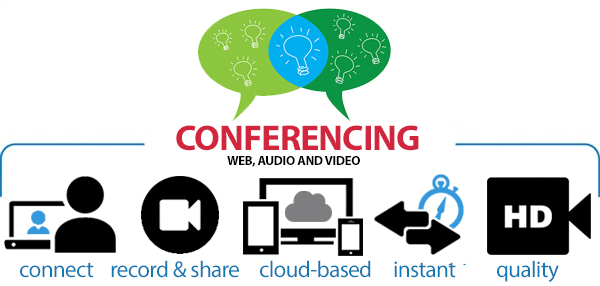Table of Contents
Types of Video Conferencing:
Video Conferencing is alive, different Types of Video Conferencing visual connection between two or more remote parties over the internet that simulates a face-to-face meeting. It is important because it joins people who are not normally able to form a face-to-face connection. Video conferencing is a live video meeting between two or more people in different locations using supporting devices.
Video conferencing refers to the transmission of pictures and imagery(via video) and sound (via audio) between two or more physically separate locations. So, the sole province of the corporate boardroom, video conferencing is used today in different areas. In telemedicine, distance education, theatrical productions, political trials, and other circumstances in which the ability to “be here now” is desired.

Types of Video Conferencing:
There are various kinds of video conferencing systems in the market for individual use or to use with multiple people. In order to find out the best video conferencing systems for your business needs, knowing the different types of video conferencing systems available in the market is necessary.
Video conferencing technology has enabled us to seamlessly connect face to face with people all over the world. It is usage has exploded in recent years and become a fundamental tool for global companies. Among the most common and major types of video conference systems are telepresence, integrated, desktop, service-based, and codec.
Depending on your needs, there are different types of video conferencing systems you can choose from. Among the most video conferencing are here below. You can study them from here one by one. We provide the most popular types here for you.
1.Desktop Video Conferencing:
The most common use of desktop video conferencing is available to see on desktop computers or laptops. These are simple to use, any user can install the software and get instant access to communication. All the things required are a webcam and microphone. Which generally these days is on the laptop.
2. Conversation Video Conferencing:
The most common and intimate way people use video conferencing is through one-to-one video calls. This allows managers to effectively manage remote employees and have private one-on-one video chats.
3. Service-based Video Conferencing:
In service-based systems, the provider which often is a telecom carrier handles the majority of the control when it comes to the network setup. This means less work on your end. You just pay for the solution and your provider manages it for you making it more convenient especially if you don’t want to bother with the technicalities.
4. Telepresence Video Conferencing:
Telepresence video conferencing is available to host a meeting as closely as possible. Even if the participants are not in the same room physically, the step-up is done in a way easily. Large screens are used and cameras are positioned at eye level. The result is a video conference set-up that appears as if all the participants are sitting in the same room and around the same.
5.Internal Video calls/Team Meetings:
Rather, internal video meetings are essential for keeping all team members in the loop. Especially for companies that have remote employees and more than one office location. Face-to-face team meetings let you connect with your team members on a deeper level. It helps create a collaborative and stimulating environment to ensure everyone on your team is being seen and heard while working together as one unit.
6. External video calls/Customer & vendor relationships:
So, it is obvious that it’s easier to build better client relationships when you can see them face to face. When meeting with customers and outside vendors in person isn’t an option. Video conferencing provides a great alternative. External video calls also work well for call center customers services with ACD systems your call agents can rely on.
7.Integrated Video Conferencing:
Integrated video conference service is available for group video conferencing. Where there is a centralized location for the equipment. It includes both the hardware and codec. All the main cameras, displays, and other peripheral videos are in the main conference location. Integrated video conferencing systems are typically ideal for boardroom and classroom conferences.
8. Personal Video Conferencing:
So, let’s get connect wherever you are. These types of solutions are the best to get collaborate with others. Also, this personal video conferencing connected you wherever you are at home premises or workstation or some other place. Meet people face to face easily on your own personal device.

Conclusion:
So, the globalization of all industries drives the future of small and enterprise companies alike. Video conferencing technology is poised to be a necessary communication tool for years to come. Also with the upsurge in the unified communications era, video conferencing has reached an edge. Where every business can take leverages differently.
So, video Conferencing has grown to a point where each type can benefit your business differently. Before you decide to pick one video conferencing type, make sure that it suits your business’s needs. Whether you are having a one-to-one video call with a potential customer you are meeting for the first time or hosting a companywide town hall with hundreds of remote employees calling in. Lifesize lets your meet face to face and connect on a deeper level in the most effortless and effective way possible.


:max_bytes(150000):strip_icc()/Doctors-talking-in-video-conference-in-hospital-Ariel-Skelley-Blend-Images-Getty-5817aded5f9b581c0ba23beb-603ad8ea1e734267bdbe71b9a2ad5b10.jpg)





